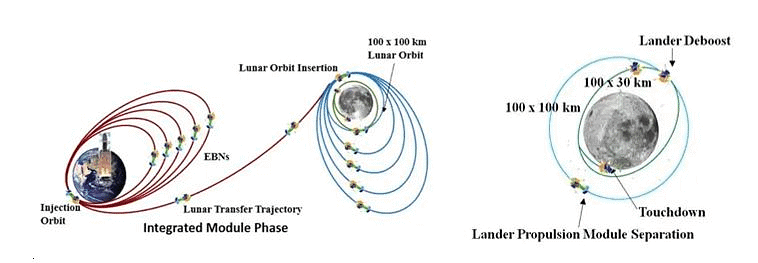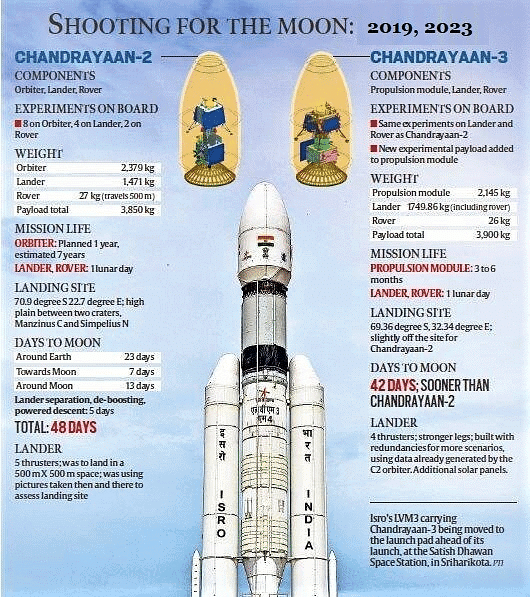UPSC Exam > UPSC Notes > Current Affairs & Hindu Analysis: Daily, Weekly & Monthly > The Hindu Editorial Analysis - 23rd August 2023
The Hindu Editorial Analysis - 23rd August 2023 | Current Affairs & Hindu Analysis: Daily, Weekly & Monthly - UPSC PDF Download

Chandrayaan-3
Why in News?
Chandrayaan 3 Mission gets ready to make history with a soft landing on Moon’s surface. Indian spacecraft has reached closer to the Moon and is all set to soft-land on the lunar surface by August 23, Wednesday. ISRO said it successfully reduced the orbit of the Chandrayaan-3 mission’s Lander Module (LM).
- The highly anticipated landing time of India’s third edition of the lunar mission series is less than 48 hours away – scheduled for Wednesday. Whereas a dismal conclusion to the mission was revealed by Roscosmos on Sunday afternoon Luna-25 Mission had crashed-landed on the Moon’s surface. Chandrayaan-3 is almost ready to descend on Wednesday at around 5.45 pm IST.
What is Chandrayaan-3 Mission?
- Chandrayaan-3 is India’s third lunar mission.
- It is a follow-on to the unsuccessful 2019 lunar mission - Chandrayaan-2.
- It will demonstrate India’s end-to-end capability in safe landing and roving on the lunar surface.
- Objective - The mission’s main objectives are:
- To demonstrate safe and soft landing on the lunar surface
- To demonstrate rover roving on the moon and
- To conduct in-situ (on-site) scientific experiments.
- It also aims to develop and demonstrate new technologies required for interplanetary missions.
- The success of the emission will make Chandrayaan-3, the world’s first mission to soft-land near the lunar South Pole and India, fourth country to soft-land on the moon.
How will the mission work?
- Chandrayaan-3 will be launched by LVM3 from Satish Dhawan Space Centre, Sriharikota.
- Modules - Chandrayaan-3 spacecraft is a composite of three modules.
- A Propulsion module (PM): Life - 3-6 months
- An indigenous Lander module (LM) - Vikram
- A Rover - Pragyan
- Timeframe - India’s Chandrayaan missions take a month to reach the moon.
- Slingshot Manoeuvre - The Chandrayaan-3, like Chandrayaan-2, will take a rather long interesting route to the Moon.
- It will circle the Earth 5-6 times, then sling off to the Moon.
- This manoeuvre uses Earth’s gravity to impart velocity to the spacecraft thereby reducing the fuel used.
- This reduces the need to carry enormous amount of fuel thereby reducing the heaviness of the rocket.
- Lunar Orbit - The module enters lunar orbit and the reverse will happen.
- Loop-by-loop the spacecraft will get closer to the moon until it reaches a circular path 100 km above the moon's surface before the lander separates.
- On the Moon - The lander will soft land at a specified lunar site (lunar South Pole) and deploy the rover.
- The rover will explore the lunar terrain for 14 Earth days (1 lunar day) and will carry out in-situ chemical analysis of the lunar surface.

What are the payloads carried by Chandrayaaan-3?
- Propulsion Module payload: It has one scientific payload - Spectro-polarimetry of Habitable Planet Earth (SHAPE), which will be operated post separation of the lander module.
- SHAPE is to study the spectral and Polari metric measurements of Earth from the lunar orbit and also will look for smaller planets that might be habitable in the reflected light.
- Lander Module payloads:
- ChaSTE (Chandra’s Surface Thermophysical Experiment) - To measure the thermal conductivity and temperature;
- ILSA (Instrument for Lunar Seismic Activity) - For measuring the seismicity around the landing site;
- LP (Langmuir Probe) - To estimate the plasma density and its variations.
- Rover payloads: Has 2 payloads for deriving the elemental composition in the vicinity of landing site.
- Alpha Particle X-ray Spectrometer (APXS)
- Laser Induced Breakdown Spectroscope (LIBS)
How different is Chandrayaan-3 from Chandrayaan-2?
- ISRO has designed Chandrayaan-3 with a failure-based approach.
- Based on lessons learned from Chandrayaan-2, Chandrayaan-3 was upgraded such as -
- The lander incorporates enhanced features to ensure a successful landing by overcoming obstacles.
- The rover is equipped with hazard detection and avoidance systems, ensuring a safe traversal of the moon's surface.
- Orbiter - Chandrayaan-3 will not carry an orbiter but it will use data from the Chandrayaan-2 orbiter.
- Landing site - The site is at around 70 degree S near the Southern pole of the moon.
- It has been fed with high resolution pictures captured by the Chandrayaan-2 orbiter and does not depend only on pictures clicked during descent to determine landing.
- The landing area has also been expanded from a patch of 500mx500m to a broad 4kmx2.4km area.
- Weight - Due to the modifications made for a safe landing, the weight of the payload is slightly more than the previous mission.
- More fuel - Travel longer distances to the landing site or an alternate landing site, if needed.
How significant is the Chandrayaan-3 mission?
- It represents ISRO’s commitment to pushing boundaries and expanding our understanding of the moon and beyond.
- ISRO aims to mitigate risks and ensure a successful mission, by taking a failure-based approach in its design.
- The mission’s success will further solidify India’s position as a prominent player in the realm of space exploration.
- It has enormous promise for the future of space travel and interplanetary missions.
- The data from this is likely to benefit NASA's Artemis program, as India has signed NASA’s Artemis Accord.
Quick Facts
Launch Vehicle Mark-III (LVM3)
- Launch Vehicle Mark-III (LVM3), is a three-stage medium-lift launch vehicle developed by ISRO.
- Earlier known as ‘GSLV Mk-III’, it is the most powerful rocket in the ISRO’s stable.
- The 3-stages includes two solid boosters (S200), the core liquid fuel-based stage (L110), and the cryogenic upper stage (C25) which uses cryogenic engine (CE20).
- It can carry a payload of up to 8,000 kilograms to a low-Earth orbit (LEO) and about 4,000 kilograms of payload to a geostationary transfer orbit (GTO).
- LVM-3 was used also in launching Chandrayaan-2.
Chandrayaan - 2 & 3 - Comparison

The document The Hindu Editorial Analysis - 23rd August 2023 | Current Affairs & Hindu Analysis: Daily, Weekly & Monthly - UPSC is a part of the UPSC Course Current Affairs & Hindu Analysis: Daily, Weekly & Monthly.
All you need of UPSC at this link: UPSC
|
38 videos|5293 docs|1118 tests
|
Related Searches
















